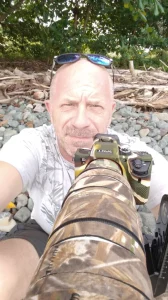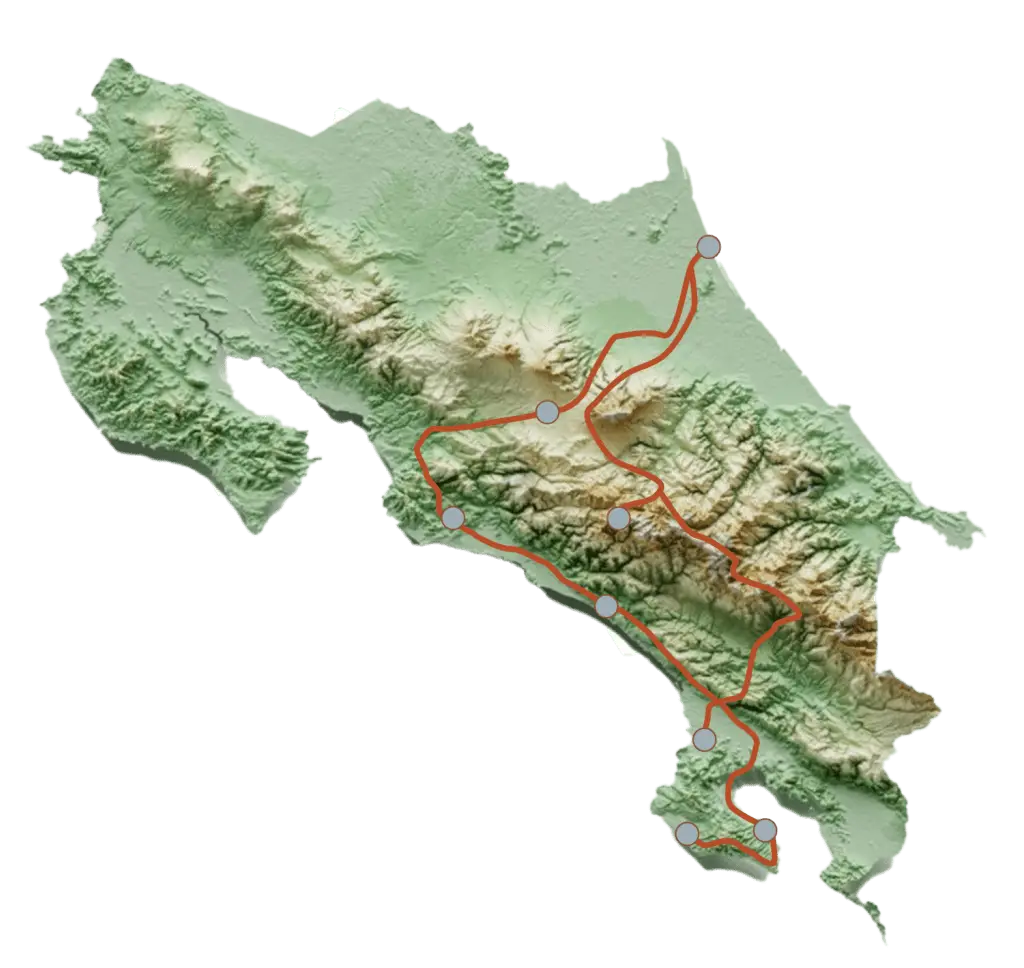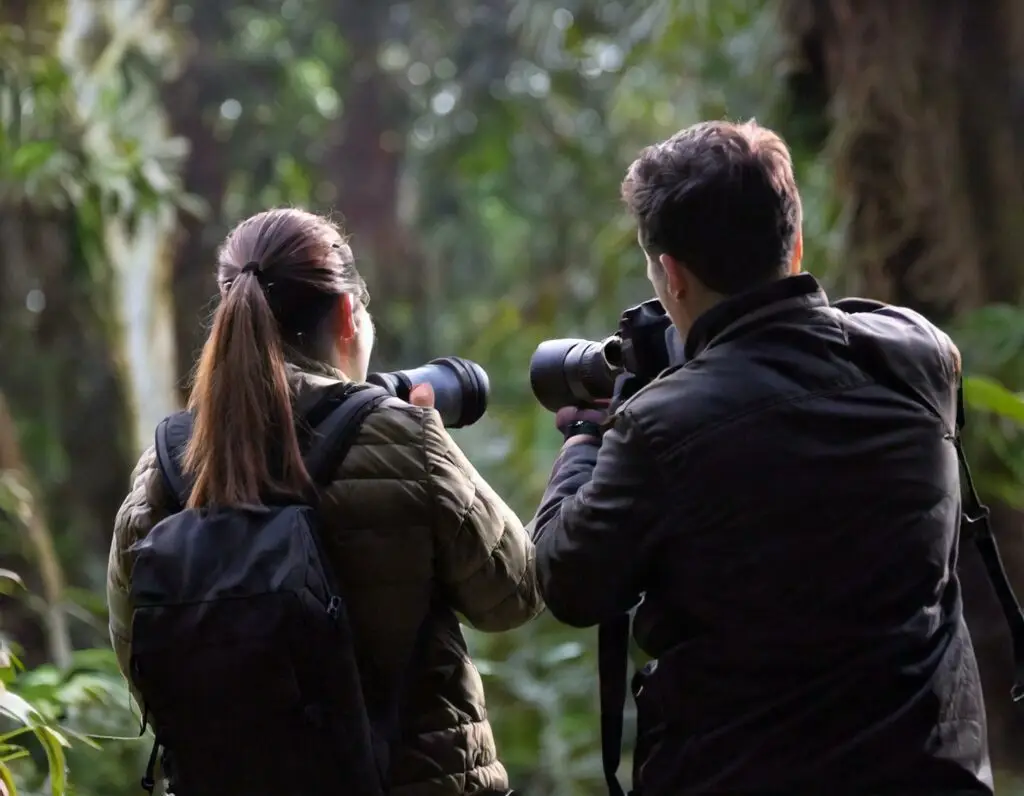The Wonders of the Naturalist
Embark on an Unforgettable Naturalist Adventure, Blending Must-See Discoveries and Unexplored Trails.
Costa Rica, thanks to its exemplary protection of natural riches, is now a leading destination for global ecotourism. Although modest in size, this tropical country is home to nearly 6% of the world’s biodiversity, making it a true sanctuary for nature lovers and outdoor adventure enthusiasts.
Your safari will immerse you in diverse ecosystems, from the beaches of the Caribbean coast to the wild shores of the Pacific, including the volcanoes and lush forests of the central mountain range. You will observe iconic species such as toucans, sloths, monkeys, frogs, and iguanas.
Accompanied by a certified naturalist guide, you will discover the diversity of tropical ecosystems. Whether on daytime walks or nighttime outings, each observation moment will be an opportunity to learn and marvel at the incredible natural wealth of this country.
From 4 900 $
For more information
or to book

Nicolas GILBERT
Naturalist Guide
Filmmaker and Photographer
WhatsApp : +506 8728 1390
Day 1: San José (Costa Rica) – Arrival
Day 2: Tortuguero National Park
Day 3: Tortuguero National Park
Day 4: Transfer to San Gerardo de Dota
Day 5: San Gerardo de Dota (Quetzal)
Day 6: Transfer to Sierpe
Day 7: Sierpe (Mangrove – Night Tour)
Day 8: Transfer to Puerto Jimenez (Corcovado National Park)
Day 9: Corcovado National Park + Overnight in the Park
Day 10: Corcovado National Park
Day 11: Puerto Jimenez – Matapalo
Day 12: Transfer to Uvita
Day 13: Uvita – Dominical (Waterfall)
Day 14: Carara National Park
Day 15: Transfer to the capital according to flight schedules.
Day 16: Arrival in Paris. End of your nature trip to Costa Rica.

Effort: Accessible to all
Your adventurous spirit values time spent discovering: daily walks to explore sites and connect with local cultures and people.
Charming Hotels and Guesthouses
Settle comfortably into small hotels or guesthouses meticulously selected for their unique character and welcoming ambiance. These cozy and friendly places, though modest, offer attentive service that allows our travelers to fully savor each stage of their journey.
Intimate Accommodation
Enjoy the tranquility and intimate atmosphere of these small hotel settings. Their authentic charm, limited number of rooms, and warm hospitality are sure to captivate you. Whether staying in nature or in the city, you’ll appreciate both the services offered and the prime location of these accommodations.
Passport valid for 6 months after the return date is required for French nationals.
DARWIN Costa Rica disclaims all responsibility if your entry to the country is denied due to non-compliance with this customs rule.
A visa is not required for French nationals for stays of 3 months or less.
Note: If you have a layover in the USA, check the current formalities at the time of travel. For transits through the USA (even as a layover), an optical or biometric passport and an ESTA form (mandatory as of January 12, 2009) must be completed at least 72 hours before the trip: https://esta.cbp.dhs.gov.
For travelers with an optical passport issued after October 26, 2005, and passing through the USA, a visa application is required: type B1 or B2. This application must be submitted directly to the U.S. authorities (processing time of about 8 weeks). – websites: www.amb-usa.fr www.bern.usembassy.gov.
Note: All children, regardless of age, must have their own passport.
No mandatory vaccinations are required for entry into Costa Rica. The country is generally safe in terms of hygiene.
However, the yellow fever vaccine is mandatory if you have visited certain countries prior to arrival. Additionally, it is recommended to be vaccinated against typhoid, hepatitis A and B, as well as tetanus and polio.
Malaria is the main concern for travelers. For short stays (less than a month), a preventive treatment is advised. Consult your doctor to choose the most appropriate prophylaxis.
Costa Rica is classified as a Zone 1 area for malaria risk. It is also recommended to use mosquito repellent (readily available locally) and wear long clothing in the evening and early morning.
A pre-trip consultation with your doctor for health advice is highly recommended.
Recommended Equipment:
CLOTHING
FOOTWEAR
OTHER ACCESSORIES (besides photo equipment):
DO NOT FORGET:
CAMERA BODY
We recommend having at least two camera bodies for better responsiveness in different situations, reducing the need to switch lenses (and avoiding dust, falls, etc.). Whether DSLR or mirrorless, choose a camera with fast autofocus and a good burst mode.
MEMORY CARD
Depending on your camera and your storage habits, it’s wise to bring several memory cards of 16, 32, 64, or even 128 GB or more. Newer DSLR and mirrorless models are highly demanding on storage due to large file sizes and burst shooting, especially when shooting in RAW.
Consider bringing a laptop and a 1TB SSD external hard drive to back up photos each evening, but watch out for weight restrictions.
LENSES
For a wildlife safari, bring at least a 300mm or equivalent lens for animals, a wide-angle lens for landscapes or close situations, and a macro lens.
Cropped-sensor DSLRs provide a 1.5x magnification, so a 300mm lens effectively becomes a 450mm, and a 400mm becomes a 600mm. Full-frame and mirrorless bodies keep the focal length unchanged.
To cover a broad range from wide-angle to super-telephoto, many combinations are possible. Zoom lenses are more versatile than fixed focal lengths, giving you framing flexibility and the ability to adapt to any situation.
For optimal image quality, choose bright lenses with f/4 or, ideally, f/2.8 apertures (though these can be pricey).
POWER SUPPLY
Charge batteries whenever possible to keep them full.
OBSERVATION EQUIPMENT
A pair of binoculars is also recommended.
OTHER ACCESSORIES
Depending on your destination, consider:
WEIGHT CONSTRAINTS
Your photographic gear in carry-on bags must meet airline weight restrictions. Batteries should travel in your carry-on photo bag, while accessories (monopod, tripod, spare charger, bean bag, etc.) should be packed in checked luggage.
A backpack is usually the best travel option, with some models even offering wheels for added convenience.
Our Naturalist Guide, Filmmaker, and Photographer
Nicolas Gilbert is more than just a guid; he’s a nature enthusiast, a storyteller, and a visual artist. With deep expertise in Costa Rica’s wildlife and flora, he takes you on a journey to discover the natural treasures of this country through unique and immersive photo safaris.
As a naturalist, filmmaker, and photographer, Nicolas shares his passion for photography and Costa Rica’s exceptional biodiversity with you. Each moment spent with him becomes an opportunity to learn, admire, and capture nature in all its splendor.
.
